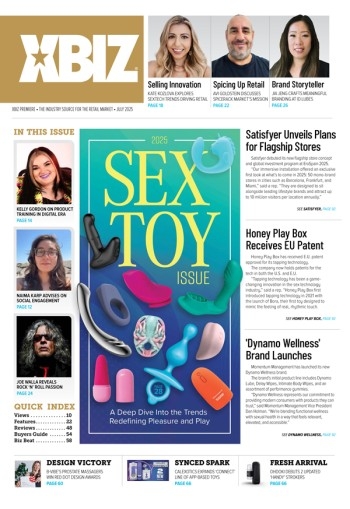Pride Month is a time of visibility, joy and self-expression. In the pleasure industry, projecting that energy can start with something as simple as a box. Market research shows that 72% of U.S. consumers say product packaging influences their purchasing decisions. Inclusive, intentional design can make a lasting impression, shaping how customers connect with a brand from the start.
In a space centered on intimacy, confidence and personal discovery, packaging also has the power to celebrate the diversity of the queer community. From inclusive language to vibrant visuals, every design choice is an opportunity to say: “You are seen. You are valued. This space is for you.”
When your packaging reflects real intention, it doesn’t just stand out, it reinforces your brand, builds loyalty, and shows customers what you truly stand for.
Design the Experience, Not Just the Package
Thoughtful packaging design can instantly convey whom your brand is for and make customers feel welcome. Start with structure. Avoid strictly gendered shapes, symbols or descriptors. Instead, consider versatile, discreet designs like matte black tubes, soft gradient boxes or minimalist pouches that allow customers of all identities to feel ownership over the experience.
Instead of relying on pink or blue coding, lean into soft curves, clean typography and mood-forward color palettes like deep plum, soft jade or bold neutrals.
Want to go further? Include optional sticker packs, blank “for/from” notes or unbranded packaging options, to allow shoppers to personalize their experience. These small touches transform unboxing into a moment of self-expression, and in a retail setting, they can be the detail that encourages a customer to pick up your product.
Use Storytelling That Affirms, Not Assumes
The language on your packaging is your brand’s voice, and that voice should feel welcoming. Consider swapping gendered terminology with usage-based phrasing like “designed for external stimulation” or “ideal for G-spot or prostate play.” Wherever possible, reference anatomy and sensation, not identity.
Offering gender-neutral alternatives helps more customers feel seen. Terms like “designed for vulva owners” or “made for penis owners” can be helpful when describing function and fit. These phrases center the experience without making assumptions about how someone identifies.
Add small guides or QR codes that link to video tutorials, pleasure maps or FAQs designed to support a wide range of bodies and experiences. Use a mix of affirming and instructional storytelling on inner flaps or product inserts. Use tactile printing like embossing or spot UV to elevate key terms like “Explore,” “Celebrate” or “Pleasure Your Way.” The goal is to educate with intention, using language that invites everyone in with clarity, confidence and care.
Let Your Imagery Speak to Inclusion
Visual storytelling is often the fastest way to determine a brand’s intentions. Go beyond stock photography and consider illustrations, silhouettes or abstract motifs that celebrate queer aesthetics without relying on rainbow iconography.
If you use photos, make them count. Include body-diverse models, queer couples, and trans or nonbinary representation across your print and digital assets. Representation shouldn’t just be symbolic; it should reflect the real people you serve. When customers see themselves reflected authentically, it builds trust, deepens connection and signals that your commitment to inclusion goes beyond the surface.
On retail shelves, inclusive imagery often does more than stand out; it makes customers feel seen before they even touch the product.
Make Packaging Authentic, Not Performative
Pride-themed packaging can be a powerful gesture, but only when it reflects a deeper commitment. Customers are attuned to whether brands are showing up with real support or simply capitalizing on the moment. Rainbow overlays and one-liner affirmations fall short if they’re not backed by action, intention and inclusivity that extends beyond June.
If you’re updating packaging for Pride, ask: What does this communicate about our brand year-round? Does it reflect who we are, whom we hire and whom we support? Are we telling real stories or just decorating the surface?
Here are a few ways to bring substance into your packaging:
- Use the space to share your values or spotlight community initiatives.
- Feature voices from LGBTQ+ team members or collaborators.
- Provide accessible links to resources, education or nonprofits you support.
Prideful packaging doesn’t have to be loud and colorful to be meaningful. Leading with integrity resonates more than rainbows.
Collaborate With LGBTQ+ Designers From Start to Shelf
Partnering with LGBTQ+ creatives brings fresh insight, lived experience and meaningful representation to your packaging. From structural designers to illustrators and copywriters, these collaborators help ensure your design choices resonate beyond surface-level gestures.
Not sure where to start? Here are some hints:
- Tap queer design collectives through inclusive creative directories or community networks.
- Co-create a limited-edition Pride box with an LGBTQ+ artist and share their story on the outer sleeve.
- Run a packaging redesign contest during Pride and highlight submissions on your social media or in store displays.
True inclusion starts behind the scenes. By inviting the right voices into the process early, you create packaging that’s not only beautiful, but also aligned with the audience it’s meant to serve.
Extend Inclusion Beyond the Box
Unboxing might happen at home, but inclusion starts on the shelf. Your packaging sets the tone, but the whole retail experience should reinforce it.
Ensure store staff are prepared to create an open, approachable and affirming environment for everyone. Their presence and product knowledge help bridge the gap between what’s on the box and how customers feel while shopping.
Merchandise with intention. Group products not just by gender or identity, but by sensation, function or experience level to better reflect how customers explore pleasure.
Track, Listen and Improve
The best packaging decisions come from listening. Host small focus groups or talk directly with your community to learn how your packaging is landing, what feels affirming, what feels off and what could be better.
Encourage sales reps and retail teams to relay feedback from the field. These frontline insights are often the first sign of what’s resonating, or what needs to evolve.
Make it easy for customers to share their thoughts. Add a QR code to the box or include a prompt in post-purchase emails asking how the packaging made them feel. Encourage unboxing videos and tagged content on social to see what elements your audience is engaging with most.
When you treat packaging as a two-way conversation, your community becomes part of the design process — and your brand becomes stronger because of it.
Make Pride a Year-Round Practice
In a crowded retail environment, brands that lead with purpose, not just promotions, build the most profound loyalty. Inclusive packaging is a strategic advantage, but it is also a celebration of community, creativity and care.
This June, let your packaging reflect the joy, expression and love at the heart of Pride. But don’t stop there. Keep designing for inclusion all year long. When your packaging reflects real intention, it doesn’t just stand out, it reinforces your brand, builds loyalty, and shows customers what you truly stand for.
Matthew Spindler is the associate marketing manager for Blush.








